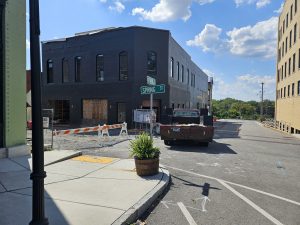Brady Flanigan
Editor
Every Saturday morning in Shelbyville, Tennessee, the sun rises over the hilltop courthouse and casts long sunbeams through the eastward windows. Trucks orbit the square in a lazy carousel, and storefronts lean inward like neighbors locked in conversation. To stand here is to stand inside a diagram. In 1810, decades before anyone murmured the words “urban planning,” Shelbyville laid out its downtown this way: courthouse in the center, streets running out the corners of four inward facing blocks. But it’s this unassuming Middle Tennessee square that became the blueprint for town centers from Texas to Indiana, replicated county by county until the format became as natural as the Gulf breeze.
Shelbyville was a frontier county seat when surveyors staked it out along the Duck River. The courthouse was given a full block of its own to act as the beating heart of town. At the time it was the perfect mixture of civic theater and shrewd economics. By centering the courthouse and shifting the streets to the corners, they maximized retail space and ensured during some hour of the day, somebody was always in the shadow of the law. Over the years, historians and planners would adopt the moniker “Shelbyville Plan,” but it was invented as a balance between symbolism and pragmatism.
The Shelbyville Plan didn’t stay Shelbyville’s for long. You can trace it in the paperwork. Other towns followed in its lead—some verbatim. In Liberty, Indiana, the National Register calls out the layout explicitly as the “Shelbyville Plan,” an isolated courthouse in the center and the roads shooting off the corners. Historical square-markers in Missouri and Kansas use the same language. In Indiana, 79 of its 92 counties adopted this model. In Texas, it’s even higher, with 157 courthouses built on the blueprint.
The proof isn’t in numbers though. It’s in the soil. Head to Granbury, Texas, and it’s resting there in limestone. The courthouse doesn’t just reside in the square—it anchors the square. Four streets slide into its corners, antique shops and barbecue restaurants pointing their glass facades towards the courthouse. In the evening, the sidewalks buzz with string lights and small-town chatter. It’s Shelbyville’s geometry reborn in the dry Texas heat. On the rolling uplands of Troy, Kansas, the story repeats with brick-lined streets and a ruby-red Romanesque Revival courthouse. Streets feed the corners, and the seat of government standing watch over endless fields. And in Bloomington, Indiana, the Shelbyville Plan is so common it’s hardly noticed—shops facing the scales of justice and roads spilling out the corners. It’s so widespread it isn’t imitation anymore.
Not every square follows the Shelbyville Plan. There’s Savannah’s Oglethorpe Plan, drawn a century earlier, scattered its wards along a military grid: little patches of green spread throughout town for equal allotment and defense, in the event of invasion. Spanish colonial towns to the west followed the Law of the Indies, with churches and cabildo on the plazas, where god and government came together. In New England, town centers were simple greens turned civic centers—more accident than design.
Shelbyville’s plan is none of these. It isn’t liturgical like Spanish plaza or defensive like Oglethorpe or improvised like the green. It was deliberate and designed: a courthouse has its own block, streets exit at the sides of the stage. It was a place where theater and commerce converged. It was a layout designed to say where power resided.
These other urban planning patterns matter, but it was along the Duck River, in the Southern Uplands, that a design was born that spread across the Great Plains and the Texas Highlands and the Grain Belt.
Two centuries later, Shelbyville’s square still works. Horse trailers and box trucks still go round and round, beneath the revolving courthouse clock. Judges and children cut across the lawn, shopkeepers stand in the shadow of the courthouse, restocking shelves and selling coffee. It’s not ceremony anymore. It’s just habit, geometry stuck in the dirt so long it’s invisible.
Across the South and the Midwest, the same story keeps playing out. Farmers markets pitch tents on courthouse lawns in the autumn. Christmas floats round the corners in the winter. Car shows, political rallies, chili competitions—all of them orbit the courthouse block like the sun, a civic heart that never stops beating. Some towns have turned their squares into postcards, some have let them sag, but the center still holds: courthouse in the center, life swirling around it.
Shelbyville, Tennessee didn’t invent the town square. It invented an ideal for belonging that declared power to be at the center and commerce around it. It’s visible in Texas limestone, the Kansas Brick, Indiana stone. But it started on the Duck River, in the frontier county of Shelbyville, Tennessee, when a courthouse was drawn in the middle, and America built out from the corners.



